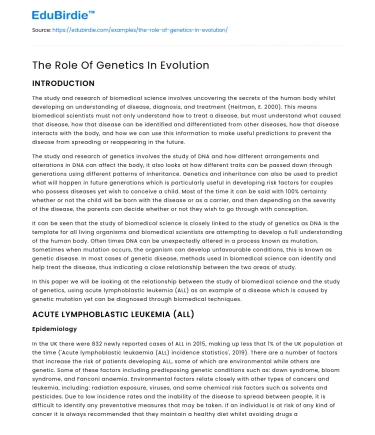INTRODUCTION
The study and research of biomedical science involves uncovering the secrets of the human body whilst developing an understanding of disease, diagnosis, and treatment (Heitman, E. 2000). This means biomedical scientists must not only understand how to treat a disease, but must understand what caused that disease, how that disease can be identified and differentiated from other diseases, how that disease interacts with the body, and how we can use this information to make useful predictions to prevent the disease from spreading or reappearing in the future.
The study and research of genetics involves the study of DNA and how different arrangements and alterations in DNA can affect the body, it also looks at how different traits can be passed down through generations using different patterns of inheritance. Genetics and inheritance can also be used to predict what will happen in future generations which is particularly useful in developing risk factors for couples who possess diseases yet wish to conceive a child. Most of the time it can be said with 100% certainty whether or not the child will be born with the disease or as a carrier, and then depending on the severity of the disease, the parents can decide whether or not they wish to go through with conception.
Save your time!
We can take care of your essay
- Proper editing and formatting
- Free revision, title page, and bibliography
- Flexible prices and money-back guarantee
It can be seen that the study of biomedical science is closely linked to the study of genetics as DNA is the template for all living organisms and biomedical scientists are attempting to develop a full understanding of the human body. Often times DNA can be unexpectedly altered in a process known as mutation. Sometimes when mutation occurs, the organism can develop unfavourable conditions, this is known as genetic disease. In most cases of genetic disease, methods used in biomedical science can identify and help treat the disease, thus indicating a close relationship between the two areas of study.
In this paper we will be looking at the relationship between the study of biomedical science and the study of genetics, using acute lymphoblastic leukemia (ALL) as an example of a disease which is caused by genetic mutation yet can be diagnosed through biomedical techniques.
ACUTE LYMPHOBLASTIC LEUKEMIA (ALL)
Epidemiology
In the UK there were 832 newly reported cases of ALL in 2015, making up less that 1% of the UK population at the time ('Acute lymphoblastic leukaemia (ALL) incidence statistics', 2019). There are a number of factors that increase the risk of patients developing ALL, some of which are environmental while others are genetic. Some of these factors including predisposing genetic conditions such as: down syndrome, bloom syndrome, and Fanconi anaemia. Environmental factors relate closely with other types of cancers and leukemia, including: radiation exposure, viruses, and some chemical risk factors such as solvents and pesticides. Due to low incidence rates and the inability of the disease to spread between people, it is difficult to identify any preventative measures that may be taken. If an individual is at risk of any kind of cancer it is always recommended that they maintain a healthy diet whilst avoiding drugs and alcohol, as well as exercising frequently in order to reduce the risk, the same applies to leukemia.
Causes and Genetic Basis
ALL occurs through genetic mutations in dividing lymphocytes. When a lymphocyte precursor cell divides, if there is a mistake when replicating the DNA in preparation for mitosis, usually the cell would prevent itself from proliferating and be killed through apoptosis, or alternatively the malfunctioning daughter cells would be killed through apoptosis. In ALL this does not happen, the malfunctioning precursor cell is produced successfully and proceeds to proliferate at a rapid rate, often cascading as more and more precursor cells are produced, resulting in a group of abnormal lymphocytes forming and entering the blood stream. This often results in one type of lymphocyte being produced at a much higher rate than other lymphoid or myeloid cells produced in the bone marrow, resulting in a significant imbalance in the blood as one type of cell, other than red blood cells, will be highly prevalent, thus often resulting in anaemia and other potentially more harmful symptoms.
References
- Heitman, E. (2000). Ethical values in the education of biomedical researchers. The Hastings Center Report, 30(4), S40-4. Retrieved from https://search.proquest.com/docview/222388212?accountid=14620
- Terwilliger, T., & Abdul-hay, M. (2017). Acute lymphoblastic leukemia: A comprehensive review and 2017 update. Blood Cancer Journal, 7(6), 12. doi:http://dx.doi.org/10.1038/bcj.2017.53
- Burkhamer, J., Kriebel, D., & Clapp, R. (2017). The increasing toll of adolescent cancer incidence in the US. PLoS One, 12(2) doi:http://dx.doi.org/10.1371/journal.pone.0172986
- Acute lymphoblastic leukaemia (ALL) incidence statistics. (2019). Retrieved from https://www.cancerresearchuk.org/health-professional/cancer-statistics/statistics-by-cancer-type/leukaemia-all/incidence#heading-Two






 Stuck on your essay?
Stuck on your essay?

